Welcome to
Wasserburg am Inn !
Seiteninhalt
Sightseeing
Town hall

The Wasserburger Rathaus was built between 1457 and 1459 to replace the original building from 1252 – which was itself rebuilt in 1339 following the devastating town fire. The structure of the impressive late gothic building was suited to the town council activities of the time. Right up until the 1970´s. the bakers of the town all brought their bread to be sold in the bread house (today a café). The entrance hall of the town hall building used to be the corn exchange. The small auditorium on the first floor, with its murals, unchanged since they were painted in 1564, was where the local council of the time held their meetings. County council meetings were also held there, Wasserburg being the county town of Bavaria until 1806. The large auditorium as seen today was used for large celebrations such as weddings, dances and other festivals. The room was burnt out in a fire in 1874 and was fitted out in its current form between 1902 and 1904. The halls can be viewed by appointment with official guides.
Church of Our Lady with watch tower
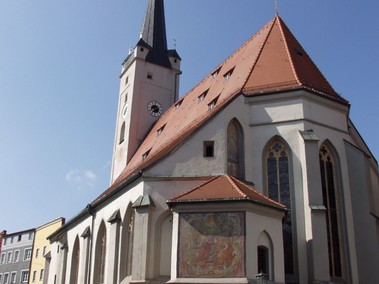
Referred to historically in 1324, the Market church is the oldest church in the town. The inside of what used to be a place of pilgrimage, was refurbished in barock style in 1753, although the gothic character of the church remained despite the removal of the main gothic elements. Of particular importance is the gothic picture of the Merciful Mother of God, in the style of “The beautiful Madonna” from approximately 1420. The barock version of the church decoration which was first discovered in 1912/13, was restored in the same style in 1974/75. The 65 metre tower used to be the watch tower – hence the coat of arms showing the lion and tower.
The house of the family Kern
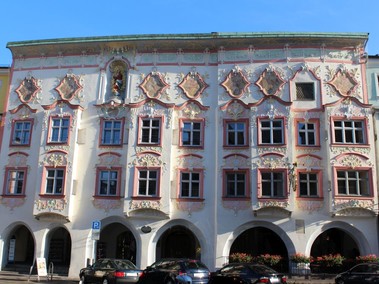
The facade of this edifice directly opposite the Rathaus was formed by the court stucco specialist Johann Baptist Zimmermann, who combined two buildings into one common facade. It is regarded as one of the most beautiful rococo facades in southern Germany and was commissioned by the unusually rich patrician family Kern. The Kernhaus passed into the hands of the town council for use as a courthouse in 1795. The local council was also situated here until 1849. The left side of the building was rebuilt as a modern courthouse in 1965/68, the right side today houses a hotel.
The Inn Bridge

The spanning of the river at its narrowest part, providing a permanent connection between opposite sides of the town, was thanks to the prosperity and privileges bestowed in the heyday of the middle ages. According to records dating from 1338, the wooden bridge was destroyed almost annually by floating ice. The last recorded such occurance was in 1929. The current bridge was then built as a replacement and the main sections were renewed once again in 1982/83.
The Bridge Gate
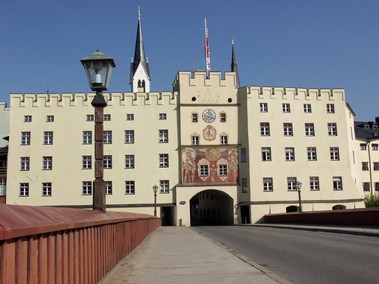
The Brucktor has been officially recorded as the main bridge entrance to the town since 1374. It has been rebuilt many times over the centuries. On the riverside front wall murals dating from 1568 can be seen. Two guards in armour are depicted holding the Bavarian and Wasserburger standards and Jupiter is represented on an eagle over a vase of lillies, carrying a bolt of lightening and a sceptre.
Hospital and Church of the Holy Ghost
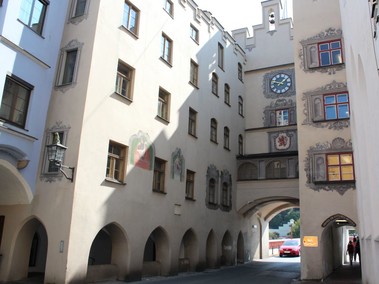
The hospital buildings on either side of the Bridge Gate were built before 1338 by the ducal guardian, Zacharias von Höhenrain. It was rebuilt as the Hospital of the Holy Ghost in 1341, two years after a fire devastated large areas of the town, and was renewed once again following further fire damage in 1380. The foundation´s purpose was fulfilled by 1970: besides its function as a hospital, the foundation provided shelter and funds for the destitute and for old people without care. The rooms on the right hand side of the gate remained empty for 40 years. Following renovation, the foundation´s purpose was continued in the form of specially adapted old peoples homes. The left hand side of the building complex has housed the Imaginäre Museum since 1978. The church, built as part of this complex, now houses one of the town´s most valuable works of art: a wooden altar carving by an unknown craftsman, from around 1500, depicting the Whitsuntide miracles.
Old and new Tollhouse

The Inn bridge offered an excellent opportunity to collect customs duty and taxes on merchandise, and so the old tollhouse whose 16th century Renaissance archways are particularly remarkable, was erected directly next to the Heiliggeist-Spital.
Later on, the official toll post was moved to the building opposite (the corner of the Shustergasse / Schmidtzeile). Prominent on the new tollhouse is the polygonal arch with its angel sculpture (W.Leb 1497) which signifies the membership of the town of Wasserbug to the rich Dukes of Bavaria-Landshut.
The Castle
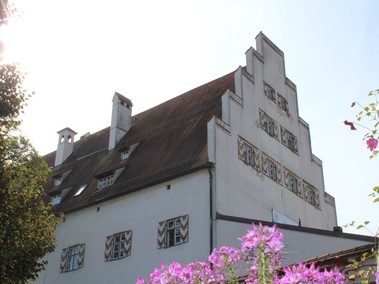
Old “Wasserburg” mentioned in a history book from 1085 as “Wazzerburch”, continued to be extended from the middle of the 12 century as the seat of the Wasserburger Hallgrafen. Its outpost and main fortress building were protected on the west and east sides by a deep ditch and by the cliffs on the south and north sides. The entrance was protected by a large fortified gate. Ludwig the Bearded from Bayern-Ingolstadt further reinforced the fortifications of the whole area in 1415 making it virtually impregnable. Duke Wilhelm IV rebuilt the fort into a ducal residence between 1531 and 1537. The castle chapel of St. Ägidien was built in its present day form in the second half of the 15th century. The castle now houses an old people´s home, therefore viewing for visitors is restricted.
St. Michael´s Church
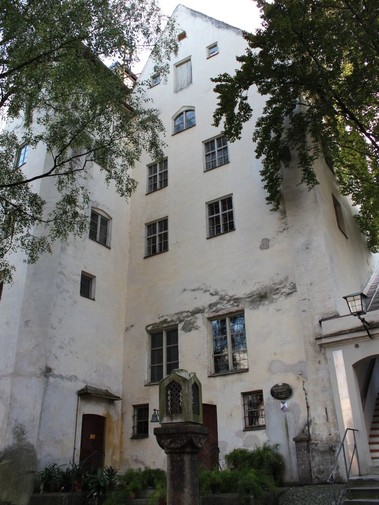
In the Schmidzeile, on the stairway connecting St. Jakob´s church and the castle, on the town side of what used to be the protective ditch, stands the earlier emblem of Wasserburg, St. Michael´s Chapel, the tower of which was broken off during the reformation. This was a late gothic church on two levels by Wolfgang Wieser. A crypt chapel for the cemetery of the time was on the lower level.
St. Jakob´s Parish Church
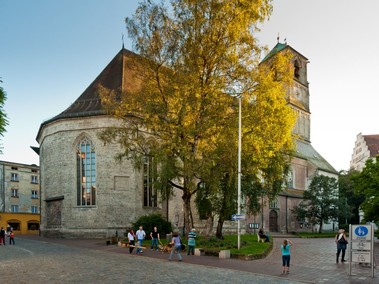
The parish church of St. Jakob was rebuilt after 1410 on the same site as the first town church from 1255. The following master builders worked on this building until its completion in 1478: Hans Stethaimer, Hans von Burghausen (builder of the St. Martin´s monastery in Landshut), Stefan Krumenauer (master builder for the archbishop of Salzburg) and Wolfgang Wieser, the Wasserburger master builder whose particular responsibility was the construction of the church tower. The inside of the building has often been changed. Following their survival of the plague in 1634, the brothers Zürn renovated the church as vowed by the citizens, in a splendid renaissance style from which only the original pulpit remained. The gravestones of many important citizens and civil servants can be seen inside the church and on the outside walls, and a traditional representation of the healing process in the form of “the tree of life” can be seen on the outside wall of the chancel.
City Wall and Cemetery

The last visible piece of the city wall can be seen, running from the red tower to the west. The entrance gate to the cemetery which has been here since 1544, was newly built in 1855 using valuable old marble epithaphs.
The Red Tower
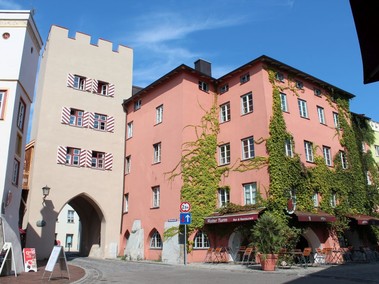
The Red Tower, integrated in the old city wall, stands today as the last gate house of the city fortifications on the spot where an earlier abutting wall which ran northwards to the Inn to protect the town from attack from the landward side at low water was. The city slaughterhouse (the Freibank) was built in the middle of the 19th century against the wall leading to the Hungerturm. Similar towers stood earlier at the end of Tränkgaase, Gerblgasse and Bahnhofsplatz (railway station square).
Max-Emanuel-chapel

The chapel is named after the elector Max Emanuel who, as many of his predecessors, set out from the shore of the river Inn to go to court meetings, weddings, war campaigns and pleasure trips. The remembrance chapel, established in 1716, later destroyed by floods, was rebuilt by the Maurerzunft (mason´s guild) which still maintains the building.
Weitere Informationen
Erleben mit Flair
Tourist Information
Marienplatz 2 (Town hall)
83512 Wasserburg
Fon: +49 8071 105-22
touristik(@)wasserburg.de
Kontakt
Rathaus & Bürgerservice:
Stadt Wasserburg a. Inn
Marienplatz 2
83512 Wasserburg a. Inn
Telefon: +49 (0) 8071 105-0
info(@)wasserburg.de
Gäste & Tourismus:
Touristinfo, Stadt Wasserburg a. Inn
Marienplatz 2
83512 Wasserburg a. Inn
Telefon: +49 (0) 8071 105-22
touristik(@)wasserburg.de




